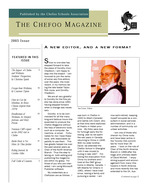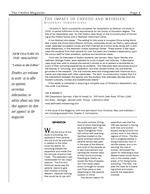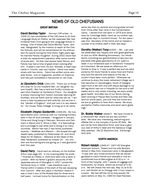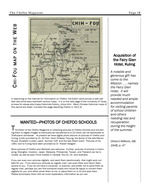| 1 |
 |
Page 1
“...Published by the Chefoo Schools Association
The Chefoo Magazine
2003 Issue
FEATURED IN THIS ISSUE
The Impact of Chefoo and Weihsien: Students ’ Perspectives, by Christina Spink 4
Escape from Weihsien. by Laurence Tipton 19
How we Got the Mistletoe, by Bruce Clinton (reprint from 1979) 23
Recollections of Weihsien. by Marjory Jackson, and Mary Previte 23
Norman Cliffs report on his 2002 visit to Chefoo 30
Bottle Rock is No More, by Theo Jordan 31
Ruling Journal, by Gordon Allen 32
Full Table of Contents 3
A NEW EDITOR, AND A NEW FORMAT
Q
ince no one else has stepped forward to take the place of Dorothy (Cox) Chadborn, I am happy to step into the breach. I am honored to join the ranks of some very fine editors over the years, the most recent, in my memory being the late Isabel Taylor, Rob Joyce, and Dorothy Chadborn.
We are all very grateful to Dorothy for the fine job she has done since 1991 having stepped forward when a change was necessary.
Dorothy is to be commended for all the many...”
|
|
| 2 |
 |
Page 2
“...The Chefoo Magazine,
Page 2
tralia and New Zealand.
I assume, due to the transition from one editor to the other, and particularly because there was a period of uncertainty when it was not clear whether the Magazine would continue, Chefusian news from Australia and New Zealand has not arrived at the time of publication. This is unfortunate, and hopefully we will see the normal flow by the time of the next issue.
The feature article in this issue will, no doubt, be of interest to all our readers. Called The Impact of Chefoo and Weihsien: Students’ Perspectives, it is an excerpt from Christina Spink’s 2000 doctoral dissertation at Widener University in the United States, titled “An Oral History Case Study on the Co-construction of Schooling at the Chefoo School and in Weihsien Internment Camp." Reference to it was made in the 2002 issue of this magazine. This is a very interesting and scholarly study which offers a balanced attempt to show, among other things, both the positive and some of...”
|
|
| 3 |
 |
Page 3
“...love to chatter
where men live quiet lives.
Peaceful clouds seem jealous when the moon is bright.
In the world,
the ten thousand affairs are not my affairs.
Editorial 1
OMF Hostels 2
UNESCO likes Kuling 3
The Impact of Chefoo and Weihsien: Students’ 4
Perspectives, by Christina D. Spink
Arthur W. Hummel, Jr. 1920-2001 12
The Erhu, by Ian Grant 13
News of Old Chefusians 14
‘Chi-Fou’ Map on the Web 18
Wanted - Photos of Chefoo Schools is
Escape from Weihsien, by Laurence Tipton 19
Books by Norman Cliff 21
Local Interest in Kuling History 22
How we got the Mistletoe, by Bruce Clinton (reprinted 23
from the Chefoo Magazine, Dec. 1979)
Recollections of Weihsien, by Marjorie Jackson, 24
and Mary Previte
Reunions 25
Books from Old China Hand Press 27
Report on my Visit to Chefoo, August 2002 39
by Norman Cliff
Bottle Rock is no more, by Theo Jordan 31
Excerpt from Gordon Allen’s Kuling Journal 32
Obituaries 34
UNESCO LIKES KULING
My only shame—
it’s autumn,
and I have no poem.
©Mike O'Connor and...”
|
|
| 4 |
 |
Page 4
“...The Chefoo Magazine
NEW FEA TURE IN
THE MAGAZINE:
“Letters to the Editor”
Readers are welcome to write in to offer an opinion, correction, information, or advice about any item that appears (or does not appear) in the magazine.
The impact of chefoo and weihsien:
Students’ perspectives
Christina D. Spink successfully completed her dissertation at Widener University in 2000, in partial fulfillment of the requirements for her Doctor of Education degree. The title of her dissertation was “An Oral History Case Study on the Co-construction of Schooling at the Chefoo School and in Weihsien Internment Camp.
In her Abstract she states: “The setting for this study is occupied China during World War II when the China Inland Mission Schools, colloquially known as Chefoo, were placed under Japanese occupation forces and then interned as a school body, along with 1,000 other Westerners, in the Weihsien Civilian Assembly Center. These events of war separated the students from their parents for over five...”
|
|
| 5 |
 |
Page 5
“...visit to Chefoo and then their leaving that made her realize what she had been missing by not being with her family. In addition, Mary was also reuniting with her two older siblings and starting with her younger brother at Chefoo. Mary had siblings to whom she mattered on a deeper level, while Kathleen had no one until her younger sister came—and even then there was little emotional attachment due to the age difference.
In their adult years, some of the Chefusians interviewed, like Mary, take the separation in stride as an acceptable part of attending Chefoo duringthat era. Kathleen, however, reflected the prevailing view of the other Chefusians that the separation resulted in life-long emotional ache. With each of the Chefusians interviewed, both male and female (thirteen percent of the one hundred fourteen who were interned without parents as well as those who were not directly affected by the war), strong emotions surrounded their words when speaking of first attending Chefoo as a boarder...”
|
|
| 6 |
 |
Page 6
“...iPa^e 6
ease of resuming family life with their having remained in China for a year after the war, and then resettling in a small mid-west, Bible-belt town in the United States. Kathleen, however, talked of the awkwardness that resulted from living as a family again. She also found the Chefoo reunions hard to cope with as she realized she did not feel that “everything was wonderful" in her pastas those around her were expressing.
Kathleen eventually sought counseling to work out her mixed feelings about the past and how they impacted the present. Other Chefusians who were interviewed struggled with putting the separation in perspective and whether or not to hold anyone responsible for that separation. One woman said that as a child,
I thought, 'It’s really God who made my parents do this, and the head of the Mission.’ And that affected my relationship with God for a long, longtime. I don’t blame my parents, the Mission, and I certainly don’t blame God now. It was just what they thought...”
|
|
| 7 |
 |
Page 7
“...The Chefoo Magazine
Page 7
peated leavings influenced who they are today. Perhaps these stories would provide a foundational basis for the future stories of those who are now in foster-care or separated from parents for a variety of societal reasons.
SCHOOLING
Whether Chefoo was the “best school east of the Suez" as Mary stated, or not, is the topic for another study. It is a credit, however, to the Chefoo teachers and staff that the school was able to maintain its high academic standards throughout the internment. These dedicated teachers provided strong preparation for succeeding on the Oxford School Certificate Exams. This is demonstrated by the fact that once the Chefoo School was settled in Weihsien Internment Camp, the students continued with their academic studies in preparation for the Oxford Exams.
Between July of 1944 and September of 1945, three groups of students, thirty-seven in all, took the Oxford Exams while interned. Of that thirty-seven, thirty-four passed satisfactory...”
|
|
| 8 |
 |
Page 8
“...living an institutional life where everyone must be on a schedule so that things run smoothly. This aspect of Chefoo made for
“Once in Weihsien, the staff and students found themselves in a different world. It was a liberating experience for the students as they were freer to talk and associate with people from whom they had previously been sheltered, from Catholic priests to nightclub performers.”
an easier transition to internment camp because the students were used to doing daily life activities by a strict schedule, whereas the other internees found it to be a limiting aspect of their previous freedom. Quite the opposite was true for the Chefusian students. The American students who were repatriated were first sent to Weihsien for two weeks before the rest of the Chefoo contingent arrived. One of these students recalled that her time during those two weeks without the Chefoo staff was unstructured. During those two weeks “it came to me that something’s different about my life. What is...”
|
|
| 9 |
 |
Page 9
“...surroundings changed and were less than best. She said:
Our teachers said just because we were in a Japanese concentration camp doesn’t mean you forget your manners. So no matter what the situation was we had to sit up straight, eat properly and always be correct in everything. At that time I think we thought they were strict, but I think we appreciated that.
Another Chefoo boy compared the Chefoo students to the Weihsien students in that,
The Chefoo schools [in Weihsien] were more disciplined...”
|
|
| 10 |
 |
Page 10
“...Pagf^)
and stricter. They had high standards and were very religious. The Weihsien schools were a happy-go-lucky collection or mixture of different ethnic groups, different foreigners from Belgium, Holland, Scandinavia and some from Britain. We got to know some of the Weihsien kids but we got the feeling that they weren’t taking education nearly as seriously as the Chefoo School. We often longed to have the lifestyle of the Weihsien kids.
Discipline
Both [Mary and Kathleen] admitted that the extreme forms of discipline used at Chefoo would be considered abusive by today’s standards, butthat it was typical for that generation of British boarding schools. The inclusion of God as judge, though, took the aspect of discipline and school life in general one step further than what most students would experience in a school. What would normally be viewed as simple acts of childhood instead became, as Mary found out when she exposed her bottom to a boy, “like you broke the heart of the Lord. . ...”
|
|
| 11 |
 |
Page 11
“...Pagf^H
Feeling Special
“Feeling special" is another student co-construction that Mary and Kathleen shared and yet on which their perspectives diverged. Again, Mary picked up on what most likely was the desired outcome of the Chefoo school staff, that she and the other students were special because they were loved by God and because they went to the Chefoo School. Kathleen, however, got a very different message. She did not feel loved by God, nor by the staff. And, any special ness she felt had to do with a racial superiority enhanced by the fact that they, as white Westerners were separated from, and treated far better than, the Chinese to whom the missionaries were there to minister. As another Chefoo student said, “We were definitely given a sense of superiority to the other missions that wasn’t right. We were no better than the others, in fact, they treated their missionaries better than our missionaries were treated."
This feeling was also reinforced in the fact that the children were...”
|
|
| 12 |
 |
Page 12
“...The^Chefoo^^a^azirw
Arthur W. Hummel, Jr., 1920-2001
RULING ON THE WEB
If you have access to the Internet, and are interested in some pictures of Kuling, you can go to the Kuling American School Association web page at www.kulingamericanschool.org. This site has recently been updated, although it still suffers from too many photos. A further revision is now in process. There are two series of pictures, one taken pre-WWII, and the other in 2002. There is also a series of photos taken at the KAS Reunion in Georgia in April 2002. The Chefoo Magazine editor and his wife attended, and they are included in some of these pictures. If interested, readers may look at picture #8 to see what we look like, then go from there. (The reader might want to stop at picture #8).
The Chefoo Magazine editor received this obituary from Oscar V. Armstrong, producer of The China Connection, shortly before his own untimely death, in 2002. Oscar said: “I am enclosing a copy of the account of the life of Arthur...”
|
|
| 13 |
 |
Page 14
“...The Chefoo Magazine
Page 14
NEWS OF OLD CHEFUSIANS
GREAT BRITAIN
David Bentley-Taylor Norman Cliff writes: In 1939 22 new candidates of the CIM came to do their Language Study at Chefoo, as the Japanese War had hindered them from going to the Language School in Anqing. One of these was David Bentley Taylor, who was "designated" by the mission to teach at the Chefoo Schools, and will be remembered for his enthusiasm for sports during his time there. Eight years ago he married Felicity Houghton. During 2002 David had a total hip replacement operation after some months of acute pain. He then had severe heart failure, and Felicity has had a time of great strain looking after him. A week's visit from his son, Michael, a heart specialist in Toronto, was very helpful. David now walks slowly with two sticks. David has written some valuable books - one on Augustine, another on Erasmus, and has just completed a manuscript on Jan Huss.
Jo (Goodwin) Crick (1941-43). Thank you to those who pray for...”
|
|
| 14 |
 |
Page 15
“...went on furlough and came back in the fall of 1923. They left Chefoo permanently in 1927. While Joe had to be tutored at home, his slightly younger brother, David Logan Dunlap, attended the school through the spring (summer) of the 1927 term and was an outstanding athlete, including cricket. Joe visited Chefoo in 1981, 1984, and 1985 and for the last time in 1995 when I was able to join him. At this point in his long and interesting life, Chefoo is probably the most important part of his memory." In a later email, Barbara wrote: “Joe and his brothers and sisters own a 'cottage’ on Lake Joseph in Muskoka (Ontario). We have passed through Barrie many times on our way up. It is always good to reach it." Editor’s note: For many years Joe Dunlap was the Chairman of the North America Branch. His service to the Association is greatly appreciated.
Vaughn (Dickson) Early (1928-36). i thoroughly enjoyed renewingChefoofriendships ata Chefoo luncheon last February in Los Angeles ata Chinese restaurant...”
|
|
| 15 |
 |
Page 16
“...The Chefoo Magazine
Page 16
Fred G. Harris (1935-1943). My brother, John s. Harris (Chefoo, 1927-39) had a major heart attack on Thanksgiving Day, November 28 last year. The nearest hospital had to restart his heart. Fortunately, by going up from his groin the doctors were able to insert a stint to keep the affected artery open and followed up with some cleaning - all without the need of open heart surgery. He was back home in five days. So I took the train out to Anaheim, California and we enjoyed 8 days of visits between rest times. John is doing very well. He is also recovering from knee replacement surgery and looking forward to regular walking again. John and Mona are at 7043 E. Viewpoint Lane, Anaheim Hills, CA 92807, and e-mail: scrab-blejm@aol.com. Also, my deceased brother David’s son, Craig, who was on dialysis due to polycystic kidney disease and also Huntington’s Disease, died unexpectedly on December 1st. I was glad to be with two of his sisters during this time. Winifred and...”
|
|
| 16 |
 |
Page 17
“...reunion in London; then finally with Jim Taylor over lunch in HK. Margaret and I visited Guilin and cruised the Li river, stayed with a university professor friend in Guangzhou and visited Macao. Our tour of Macao
included the ruins of Old St Paul’s church, built in 1602 and destroyed by fire in 1835, leaving just the impressive facade. This facade, standing at the summit of a dramatic granite staircase, is probably the finest Christian monument in the Far East. History being my one star subject at Chefoo, I savoured the scene which some 150 years ago inspired the then HK governor Sir John Bow-ringto write the famous hymn "In the Cross of Christ I glory, Towering o'er the wrecks of time..." At 74, I'm thankful to still be fit and well. Being Secretary/ Treasurer for the Wellington Branch of the NZ Chinese Language Association, together with my ongoing study of putonghua (Mandarin Chinese), keeps me out of mischief. I've been able to source a lot of Chinese feature films in DVD format for our monthly...”
|
|
| 17 |
 |
Page 18
“...Thf^Chefoc^Magaznif?
In searching on the Internet for information on Chefoo, the Editor came across a web site that had some early twentieth century maps. It is on the web page of the University of Texas, atwww.lib.utexas.edu/maps/historical/history_china.html. Many Chinese historical maps of this period are listed, included this page depicting Chefoo in 1912.*
WANTED-PHOTOS OF CHEFOO SCHOOLS
The Editor of the Chefoo Magazine is collecting pictures of Chefoo Schools and converting them to digital images to eventually be transferred to a CD which can be distributed to Chefusians worldwide. At present we have digital photo albums of pictures of Chefoo and Kuling, kindly provided by Dr. Ed Fish, Carol (Preedy) Terjung, the family of the late Marion Rouse, Elizabeth (Lutley) Leach, Norman Cliff, and the late Albert Grant. Pictures of his 1991 visit to Kuling have been provided by Dr. Robert Hallgren.
More pictures of Chefoo and Weihsien are welcome. Further, pictures of schools in Kalim-pong...”
|
|
| 18 |
 |
Page 19
“...stream,
I hear no temple bell.
Wild bamboo
divides grey clouds:
waterfalls hang
from blue peak
No way to tell
where you 've gone:
disheartened, I lean
against a second, now a third pine..
© Mike O'Connor and Stephen R. John-son 2002. Reprinted from Where the World Does not Follow: Buddhist China in Picture andPoem'mXh permission of Wisdom Publications, 199 Elm St., Sommervill MA 02144 U.S.A., www.wisdompubs.org.
Escape from weihsien
By Laurence Tipton
Everyone familiar with the history of the Chefoo School in Yantai, and the subsequent internment of students and staff at Weihsien, are also aware that two internees, Arthur Hummel, an American teacher, and Laurance Tipton, a British businessman, escaped over the wall in 1943. Both Norman Cliff (Courtyard of the Happy Way), and David Michell (A Boy’s War), make brief reference to this in their respective accounts of their experiences at Weihsien. It is very much a part of the Weihsien Concentration Camp folklore.
Laurance Tipton worked for...”
|
|
| 19 |
 |
Page 20
“...The Chefoo Magazine,
Page 20
tion after coming on duty. This usually took about ten minutes. During those ten minutes we would have to make our get-away. It was essential that there be no moon, but on the other hand we felt that a moon would be of considerable assistance to us once we had got clear of the camp; such ideal conditions would prevail on the 9th and 10th of June, which would give us exactly one week in which to prepare. Having decided on these two alternative days, we replied to Mr. Chen and advised him that the rendezvous would be at a thickly-wooded cemetery a little over a mile north-east of the camp between nine and midnight on the 9th or 10th of June.
The suspense of the ensuing week was unbearable. The knowledge that within a few days we would have finished with this futile existence made us pity the other internees who would have to endure it for the duration; the excitement and the anticipation made us longto tell the world. Each day passed like a week and each night...”
|
|
| 20 |
 |
Page 21
“...The Chefoo Magazine, 2003
Page 21
(Escape, continued from page 20)
moonlight. Approaching, he asked who we were and we replied: “Friends." he peered closely at our faces and lowered his pistol, called to the others, “Yes! It is they," whereupon the other four gathered around us, smiling and shaking our hands in an enthusiastic welcome. One of them unrolled a couple of triangular white cloth banners on which was inscribed in English: “Welcome the British and American Representatives! Hurrah! Hurrah! Hurrah!"*
BOOKS BY NORMAN CLIFF
When ordering please add 10% to cover postage and packing. Payment should be made in sterling. Enclose your remittance to: Dr. Norman H. Cliff, 4 Hall Terrace, Harold Wood, Essex RM3 OXR, UK.. (Enquiries: Tel. 01708 -342762; email: cliffnorman@aol.com).
COURTYARD OF THE HAPPY WAY. £5.00
The remarkable story of how a school of missionaries' children in north China went into internment during the Japanese war, and of how they were protected and eventually rescued...”
|
|